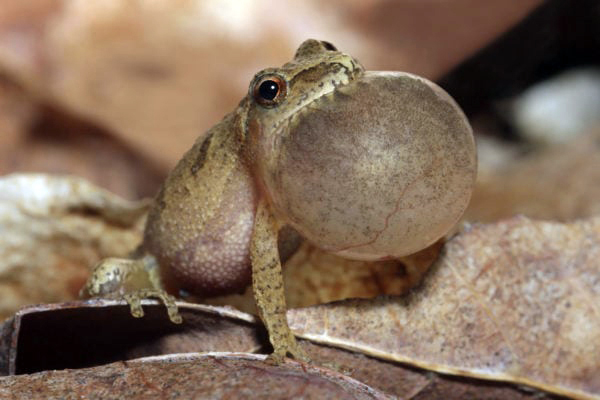
The inflated vocal sac of male peeper. (Photo courtesy Farmers’ Almanac)
Last week’s column, in which I discussed roadside litter such as disposable masks, evoked a number of responses from readers who shared in my disgust. Just as a follow-up, reader and Bristol resident Linda Shaffer wants to ensure Bristol residents are aware of the annual Elmer Tarr Bristol Roadside Cleanup, which will occur on Saturday, April 24 or anytime that week. Residents are encouraged to walk their property lines along the road and pick up trash. Plastic bags will be available at the Bristol town hall. Another reader, a frequent road walker concerned about the trash, implores drivers on our Pond roads to slow down for walkers and their dogs. We do have more walkers than ever it seems; let’s give them a break!
I am very happy to report that the peepers have begun peeping! For some, the first robin or the first crocus is their sign that spring has sprung. For me, it is having the windows open at night and listening to the peepers. It is a noise I appreciate as much as the cry of the loons or the hooting of the owls. I have never thought much about the peepers and wanted to learn more. So what did I learn?
Peepers are a member of a group of frogs referred to as “chorus frogs” because of their singing. They are actually small tree frogs, generally with a small “X” across their back. Mature peepers grow to be about 1 inch, and they feed on small bugs in their habitat. Though labeled tree frogs, they spend most of the daytime camouflaged, hiding under leaves and ground cover, which is why they are more often heard than seen!
Most tree frogs live in wooded areas and areas along the shores of ponds, rivers, and vernal pools. This makes Biscay Pond the perfect habitat for them. Mature peepers are prey for larger animals such as snakes, salamanders, and birds, while the young tadpoles are food for fish. In addition to their pleasing sound, these small creatures are important to the health of our local ecosystem.
So, why the noise? Not surprisingly, the evening peeping is part of the mating ritual with the males singing to attract females. Frequently, for unknown reasons, the males may sing in a trio, with the male with the deepest peep beginning the song. Peepers have a vocal sac under their mouth that inflates when they close their mouths and nostrils and compress their lungs. The noise results from air escaping the vocal sac. If males are successful in their calling, the females will come to the water’s edge, where fish are not present and lay her eggs, often as many as 1,200 eggs, which generally hatch in about 12 days. And the cycle of life continues.
One thing I am always curious about living on the Pond is what happens to animals in the winter. Where do these small frogs go and how do they survive our cold winter months? Well, it turns out, they don’t go very far! These frogs bury down in the ground a bit, but not below the frost line. Peepers produce their own sort of antifreeze that allows about 70% of their bodies, including their hearts, to go dormant. Scientists are still searching to understand how seemingly dead frogs thaw out and wake up. Nature is truly amazing.
Next, I am on alert for the return of our hummingbirds. Three years ago, hummingbirds appeared at our windows where we had hung feeders before we put them out. I am purposefully not putting feeders out to see if this occurs again. My hypothesis is that they will return. More on that in a future column once these beautiful critters return!






